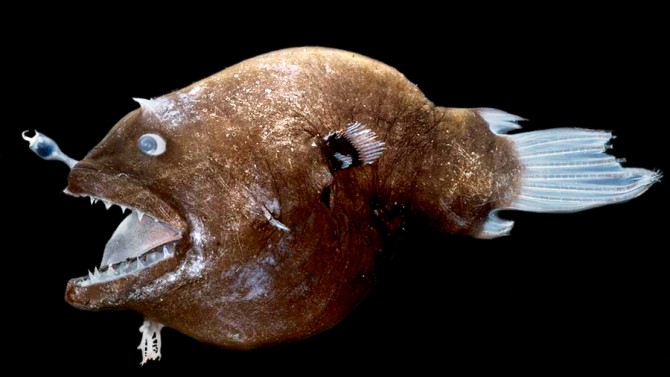Study illuminates link between anglerfish, bacteria
By Krishna Ramanujan
Female deep-sea anglerfish have a headlamp, at the end of a pole attached to their foreheads, that lights up thanks to bioluminescent bacteria that live in the lamp’s bulb.
Scientists who study these fish are still mostly in the dark about the bacteria, which share a symbiotic relationship with the fish, but a new Cornell-led study reveals that the fish most likely acquired the luminous bacteria from the water.
At the same time, the researchers – including Tory Hendry, assistant professor of microbiology and the paper’s senior author; and Lydia Baker, a postdoctoral researcher in Hendry’s lab and the paper’s first author – knew from an earlier study that based on their genomes, these bacteria did not appear fully equipped to live on their own outside a host.
The paper, “Diverse Deep-Sea Anglerfishes Share a Genetically Reduced Luminous Symbiont That Is Acquired From the Environment,” was published Oct. 1 in the journal eLife.
“In previous work that I had done, we found for the symbionts of deep-sea anglerfish that the bacteria have undergone genomic reductions; they’ve lost a lot of genes, suggesting that they are probably obligately dependent on their host,” Hendry said.
A reduced genome is a hallmark of bacteria that live their whole lives inside a host and receive services and nutrients that they no longer need instructions to acquire. Such species then lack the genetic “software” to survive on their own. And yet, Baker did genetic analysis of water samples to confirm the presence of free-floating symbionts.
In the study, the researchers obtained previously collected specimens of seven species of anglerfish across six families. They also studied the only two species of bioluminescent bacteria known to live within the bulbs of anglerfish. While one species of bacteria was specifically only found in one species of fish, the other bacteria species was found in all six of the remaining species studied. The fish were each caught in different locations, from the Gulf of Mexico to the Cape Verde islands. And while some were caught almost 20 years apart, the bacteria in the bulbs were 99% identical.
“The only way to explain that is they must be picking up that symbiont from an environmental population,” Hendry said.
Typically, when symbionts are transferred from parents to offspring, the bacteria and host follow a lineage that share a history with each other as they co-evolve, and these matching histories can be indirectly identified by looking at the fish and bacterial DNA. Yet, no shared history was detected between these symbiotic species, suggesting the bacteria were not transferred from parents to offspring.
“You can just look at it and see that there’s no pattern,” Hendry said.
Another study by collaborators in the DEEPEND Consortium revealed that anglerfish only acquire bacteria later in life once their light organ has developed. The bulb has a little pore in it, and the researchers wonder if the fish may spew bacteria into the environment once microbe populations grow, possibly to ensure that future generations of young fish have access to the luminous microbes in the water.
Given these bacteria’s reduced genomes, the next question was, how do they survive outside a host in the open water? Types of bacteria, called vibrios, sometimes have genes for a molecule called PHB, and microscopy of the luminous bacteria and light organs revealed granules that resembled PHB. It could be that these molecules allow the bacteria to store carbon and glucose from when the bacteria lived in a fish’s bulb, which they slowly use to survive over decades, Hendry said.
“They’re really long time periods that they stay in a state of stasis – not really doing much but growing a bit until they find a host,” Hendry said.
Media Contact
Get Cornell news delivered right to your inbox.
Subscribe

